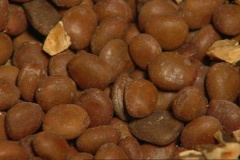Carob Beans
| Infobox on Carob Beans | |
|---|---|
| Example of Carob Beans |  |
| Facts | |
| Origin | Eastern Mediterranean |
| Stowage factor (in m3/t) | - |
| Angle of repose | - |
| Humidity / moisture | - |
| Oil content | - |
| Ventilation | See text |
| Risk factors | See text |
Carob Beans
Description
A bean shipped in bulk from the eastern Mediterranean.
The carob tree is a slow-growing but long-lived species.The carob tree should be seen as a long-term investment for future generations, especially because of its varied beneficial qualities as well as the fact that it is a protected species on the Maltese islands.
The carob beans, which are harvested locally in mid August, if not used for local consumption, are exported. The pods are locally deseeded [a process called kibbling] to produce carob kernels and carob kibbles. The kernels are then exported to be processed into long bean gum and locust germ meal while the kibbles are manufactured into animal feeds or milled into carob flour. However, the most interesting and valuable product of the pod of this tree is the carob bean gum or locust bean gum which is extracted from the kernel.
Carob, dried or roasted and having a slightly sweet taste, in powder or chip form, is used as an ingredient in cakes and cookies. Carob is sometimes used as a substitute for chocolate. The seeds, also known as locust beans, are used as animal feed. They are also the source of locust bean gum, a thickening agent used in numerous processed foods. In Egypt, carobs are consumed as a snack.
Crushed pods are used to make a refreshing drink. Compotes and liqueurs are made from carob in Turkey, Malta, Portugal, Spain and Sicily. Carob has proven effective in relieving diarrhea in infants. In Libya, a syrup extracted from carob named rub is used as a complement to an Asida meal. The so-called carob syrup made in Peru is actually from the fruit of the Prosopis nigra tree.
Carob has also been used as a non-toxic alternative to chocolate in dog treats, as the theobromine in chocolate is fatally toxic to all animals, even humans in high enough doses (in raw form).
Carob powder is created by grinding the pods of the Carob tree which is found in the Mediterranean region of the world. It is inherently gluten-free. However, as with all powdered substances, wheat flour can be added to the carob powder as an "anti-caking" agent. The flour does NOT have to be listed in the ingredients according to US law since, as defined by the FDA, flour (and the gluten found in it) is "generally recognized as safe". This standard is known as GRAS and it is bad news for celiacs.
When the seeds of the carob pod are ground up, it is called carob bean gum, or locust bean gum.
The principle component of the carob bean gum is a carbohydrate polymer, a polysaccharide which is built up of simple sugar units identified as mannose and galactose. It has the valuable property of high affinity with water, which then causes it to swell and to go into solution upon heating, thereby forming viscous solutions already in high dilutions. This viscosity, which is only little affected by salts, is therefore a measure of its effect as a thickening agent. In industry LBG has many uses in different kinds of industrial products ranging from textiles, to paper, to paints, to explosives, to oil well drilling additives, to pharmaceutical and to cosmetics. However, due to financial considerations the most important application today for the carob bean gum is as a thickening, binding, gelling and stabilizing agent in a great variety of food products [from soups to ice creams] and canned pet foods.
Shipment / Storage / Risk factors
If well dried before shipment the product will generally withstand climatic changes. If damaged through wetting may be unfit for extraction of juice. Seriously damaged beans may be utilized in the manufacture of alcohol and as a pig food. Beans of an old crop are liable to develop weevil. Liable to heat, require careful ventilation.











